Career changes aren’t always money-oriented. While UX designers can earn up to $120,000 a year according to Dashburst’s(1) analysis of UX jobs, it’s fair to say that many business managers make similar salaries. However, business managers like you are often concerned with the bottom line, and there’s no doubt that UX design has a huge impact on that bottom line; research by DMI(2) shows that companies that use UX design processes have a 228% bigger return on their investments when compared to those that don’t.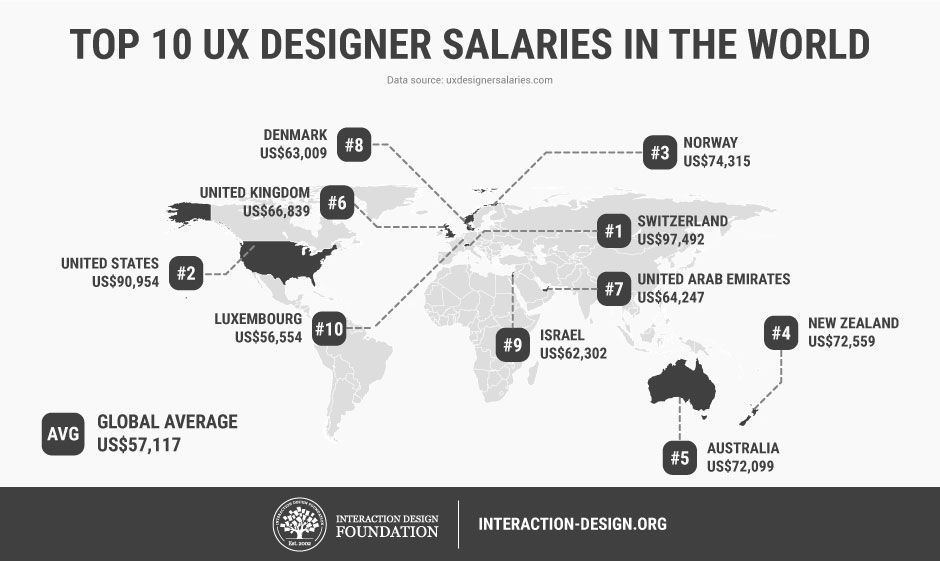
It’s also possible that you simply want to change your focus from people and processes to products. There’s something incredibly satisfying about being part of a team that creates awesome products that users love and customers rush to buy.
But how would a business manager like you make the leap to UX design when at first glance they may seem to have very little in common?
What is User Experience and User Experience Design?
First things first, let’s try to explain what user experience and user experience design is all about. User experience is the experience that a user gets from using a product. User experience design is then simply concerned with generating positive user experiences by designing better products.
User experience design is based on user research; UX designers work with users to understand their wants and needs to create products that meet those wants and needs.
The image below shows that UX design is concerned with three key areas: the look, feel and usability of a product. Products that look right create credibility and trust with users, because they are in harmony with the user’s expectations and capture the spirit of the user. UX design also delivers products that “feel right” and which are “a joy to use”, both when interacting with the product and when the user reacts to the way that the product works. Equally importantly, UX design is also concerned with usability and examines how to deliver products which are functional, predictable, and wherever possible, individual.
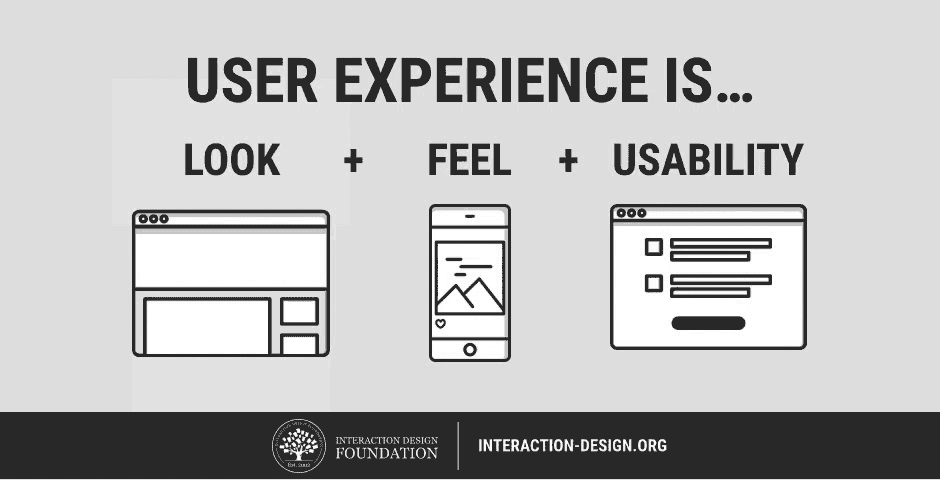
As you might expect, companies that invest in UX design are more likely to create products that users want and need than those companies which do not.
You may also find these articles helpful in expanding your basic understanding of what UX entails:
What Do Business Management and UX Design Have in Common? A focus on process
Business managers are often concerned with processes. You would have used processes (such as total quality management, enterprise risk management, etc.) to drive your business functions in your work as a business manager. You’ll tinker with those processes to see how they can be improved to create greater levels of efficiency, and generate new processes when the business needs to enter new fields or change the way that it operates.
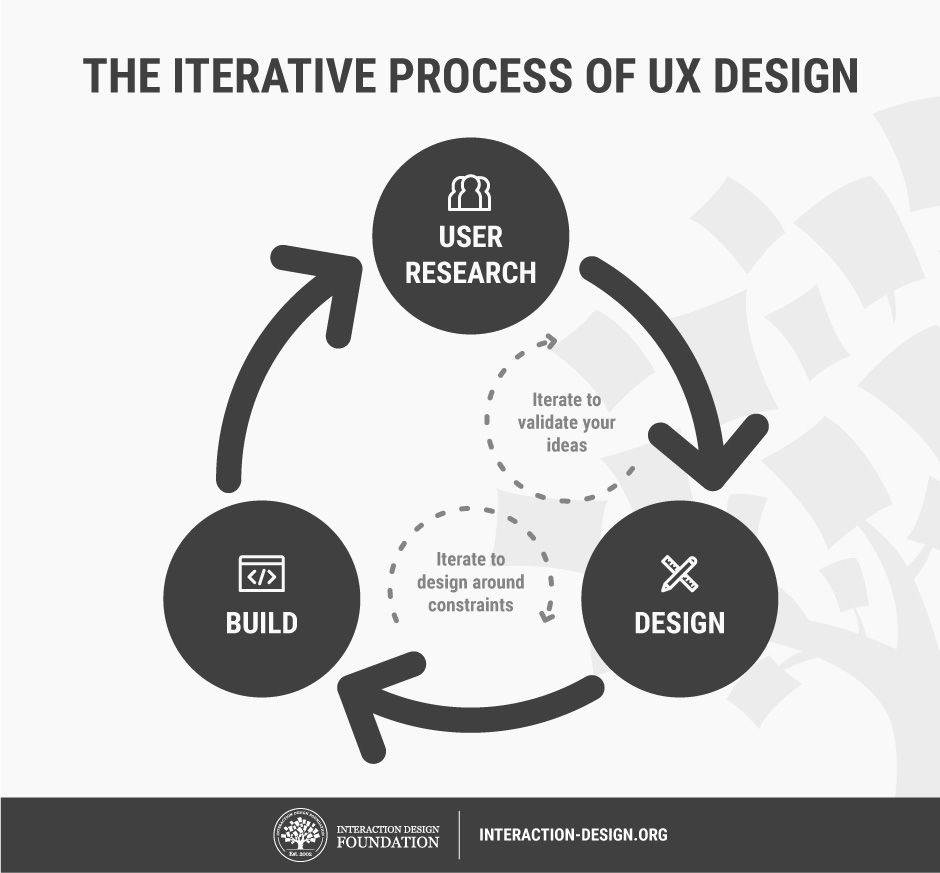
UX design is a process, too. It’s an iterative process that begins with research to discover problems that users need to be fixed. Then, more research is conducted to examine how that problem might be addressed in a useful, usable and ideally desirable manner. Thereafter, there’s a design processo be followed to create product designs based on that research. Once the product (or a facsimile of that product) is ready, it will be tested with users to see if it lives up to their expectations. If not, it will undergo another round of the design process until is ready to launch. Once it launches the process is not over; user feedback and input will drive future iterations of the product to improve it and give it market longevity.
Cross-disciplinary Working
Business unit managers will work broadly within an organization connecting different departments and roles together to achieve their objectives. Launching a new product, for instance, could easily involve the marketing, production, finance and legal departments in an organization. Similarly, UX designers work with multi-disciplinary teams of product managers, developers, visual designers, content managers, etc. to create awesome products. The outputs may be different, but the approach to cross-disciplinary working will be very similar, if not identical.
Qualitative and Quantitative
Not everything can be measured, and not everything that can be measured should be measured. You would have had targets and KPIs, which are quantitative in nature; they are the things which can be measured, such as units produced, sales made, etc. But you’d also have qualitative targets such as customer satisfaction, employee happiness, etc., which cannot be measured but add value to the business in less specific (but no less important) ways. Likewise, UX designers will work with measurable inputs to their processes and to seek measurable outputs too, but they also have to work with inputs which are qualitative in nature (such as specific feedback on a product’s performance) and adapt their work to satisfy both.
You may also have experience of interpreting research; even if it’s not something that you carry out yourself, many business units will base their strategic plans on research generated by market research or functional research companies.
Measurable ROI
Business managers are all about the return on investment (ROI). After all, it’s the measure that you need to demonstrate your worth and your business unit’s worth to management. UX design is concerned with measurable ROI too.
Think of Apple, which launched the iPod into an already developed MP3 player market and took over the market in a few short years. They then launched the iPhone into a swamped mobile phone market, reinvented the market, and established themselves as a dominant player in the luxury handset market to this day. They then took the tablet computer, reinvented it as the iPad, and popularized tablet computing around the world. All of these products are a result of investment in UX design. Apple may be the first ever company to reach a $1 trillion stock market cap—that’s a pretty impressive ROI.The Differences between Business Management and UX Design
Users Come First
Business managers are usually focused on people and/or processes within their own business. UX designers are focused on the needs of the users that usually, though not always, will lay outside of the business.
This is going to require a change of thinking from always considering what the business wants and to start focusing on what users want and need too. You’ll need to gain the necessary research skills to better understand your users so that you can implement their needs in your design work.
Persuasion vs Decision Making
Business managers will often have full decision making authority for their business units. You may take advice on how to do something, but when the time comes round for a decision, you’ll make it and the buck stops with you. UX designers usually don’t have such power. Their research and work is used to inform decision makers who will make the ultimate “buck stops with me” decisions. A UX designer needs to be a powerful persuader to best align those decision makers with their vision of a product.
The Big Benefit of Business Management when Moving to UX Design
“Big Picture Thinking”
The biggest benefit of being a business manager, when you move to UX design, is your knowledge of how businesses work and the importance of the bottom line. You’ll be able to see the “big picture” of where the product will fit in the business ecosystem more easily than someone with a straight UX design background might. You’ll be able to make judgment calls that balance user needs with business needs with a greater degree of certainty than someone whose entire focus has always been on user needs.
Organizational UX
You may also be able to take your user experience knowledge and apply it in an organizational context. We think one of the big growth areas in UX over the coming years will be the use of UX skills to enhance internal systems, products and processes with a focus on other employees as users. This is an emerging application of UX, and at the moment it’s not as common as it should be.
How to Enhance Your Skills to Make the Jump from Business Management to UX Design
There are plenty of options available to you to gain the skills you need to carry out UX work and we’ve listed a few of them here:
Online Courses
Interaction Design Foundation
We don’t like to boast, but we have the world’s largest community of UX designers as members and we offer more specialist UX courses than any other design training provider. You might think “sounds expensive”, but we’re an organization dedicated to reducing the barrier of cost of entry to learning about design.
That doesn’t mean, however, that our courses aren’t of the highest possible standard. In fact, Forbes magazine said of our online education portfolio that it’s an “Ivy League level education in UX, Product Design or Human-Computer Interaction”.
The Interaction Design Foundation has thought about what exactly people need to know to get their foot on the UX design career ladder, and we offer 3 courses to help you bridge the gap between your management skills and the UX skills you need to succeed: Become a UX Designer from Scratch, Get Your First Job as a UX (or Interaction) Designer, and User Research – Methods and Best Practices.
Of course, our offering doesn’t stop there and we offer dozens of courses that are designed to help improve your practice as a UX designer too. You can find out all about what we offer in our courses page and it’s all included in your membership fee—there are no extra charges to access our material at all.
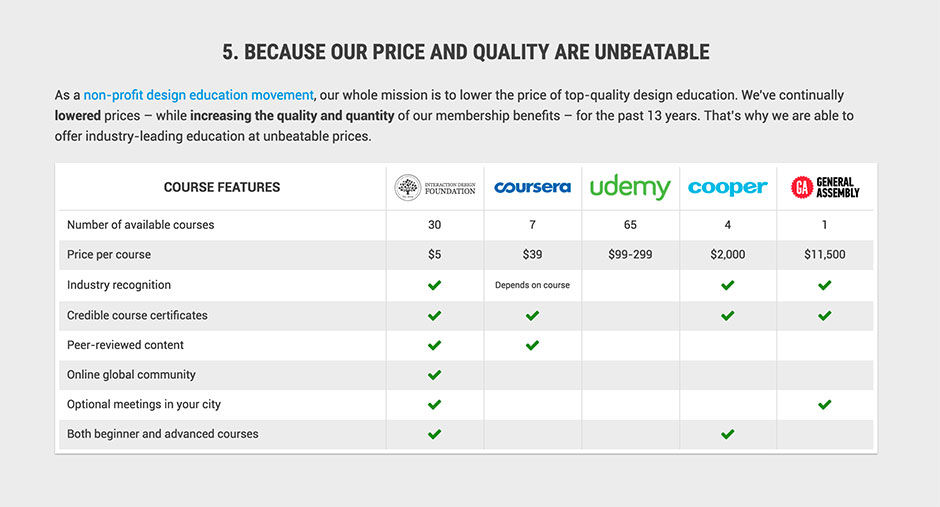
Coursera
Another great source of learning online is Coursera, which is run by a group of universities from around the world. Their learning isn’t all UX specific but they do offer some UX programs. Their charging model is different from ours in most cases you pay for each course you take, though some of their programs are free.
Udemy
Udemy is the world’s largest training marketplace. You pay per course for Udemy’s offerings in any of a thousand different disciplines including UX. The upside is the incredible volume of choice on the platform. The downside? It’s the lack of quality control; all courses on the platform are devised by independent instructors and none of them are audited by Udemy for their capabilities to teach their subjects. There are awesome instructors on Udemy, but there are many more which fail to deliver value.
Classroom Courses
If you’re not comfortable with online learning, you could invest in a classroom-based training course. Of course, it’s a much more expensive option than online learning but it can normally be squeezed into a busy life by taking a little vacation time from work to attend classes.
Nielsen Norman Group
The Nielsen Norman Group is one of the UX field’s leading consultancies and they also offer a great range of classroom based training for would-be UX professionals. Their courses are offered on an international basis, though you may have to wait a while before there’s one in your neck of the woods—otherwise don’t forget to factor in the cost of travel and hotels when you book your place.
You can find out what the Nielsen Norman Group has to offer here.
General Assembly
If short, high-intensity bootcamps are what you’re looking for, then General Assembly can be one option. However, their price is steep, and they have a limited number of locations. If their location is far from you, travel and living expenses will add to your cost of education.
You can find out what General Assembly provides in the way of UX training here.
University Courses
If you have the time and the money, you could always go to university and do a degree or Master’s degree in a UX related subject. To date there aren’t really any specialist UX degrees, and most of the degrees you will be looking at are those which focus on Human-Computer Interaction (HCI). We have our reservations about the return on investment of degree programs for those in the UX field, but you can find a couple of example courses below. If you do decide to go the university route, we strongly recommend that you do a ton of research to find the right course for you which will truly provide the opportunities you are looking for. Sadly, not all degrees are equal when it comes to the job market.
Carnegie Mellon – HCI Programs
York University – MSc in HCI Technologies
We can’t give you a figure on the cost of every university course because they differ from country-to-country and from institution-to-institution. What we can tell you is that HSBC, as reported by Top Universities(3), estimates the cost of a US university course to be $36,564 a year when you factor in tuition, rent, etc. A US university degree will last for four years; that’s $146,256!
It’s also worth noting that you are also giving up four years of paid work to do that. According to the US Census Bureau(4), the average non-graduate earns an annual income of $27,351. Therefore, you’re also giving up $109,404 in pay to go to an American university. That’s a total cost of $255,660 for a 4-year university degree! So, if you’re going to choose a university, you want to be very certain that you’re going to improve your earnings enough to get your quarter of a million dollars back.
If you’re struggling to calculate the return on investment (ROI) of each of these learning experiences, that’s OK, you’re not alone. It’s pretty tricky to gauge the impact of learning on your own bottom line and we’ve put together an article which walks you through calculating ROI on learning experiences here.

Networking
Once you’ve got the skills that you need to be a UX professional, you’ll want to start looking for a role in UX. One of the best ways to do that is to work through a personal network of UX professionals who can help identify opportunities and perhaps even put in a good word with the hiring manager for you. If you don’t already have a network like this, that’s OK—you can build one. Start on LinkedIn and join a bunch of UX related groups and contribute to them. You’ll soon find invitations to network coming your way.
We, the Interaction Design Foundation, also offer some carefully prepared networking tools to members and to non-members too. Our members can benefit from networking within courses and through our forums and that means they have access to the largest specialist design community in the world; that can come in very handy when you’re seeking an opportunity. Non-members and members alike may also attend our local group meetings which take place in towns and cities around the world; these groups are free of charge to attend and can be a great way to build a UX network in the place that you live. Find out more about our local groups in our UX community page.
As a final tip, you could also use Twitter to reach out and connect to some of the biggest influencers in the UX design community. You can use that as a chance to learn from those people as well as to network with their followers for other opportunities. To give you a head start on that, we’ve put together a list of the 20 people that you should connect with on Twitter in the UX field.
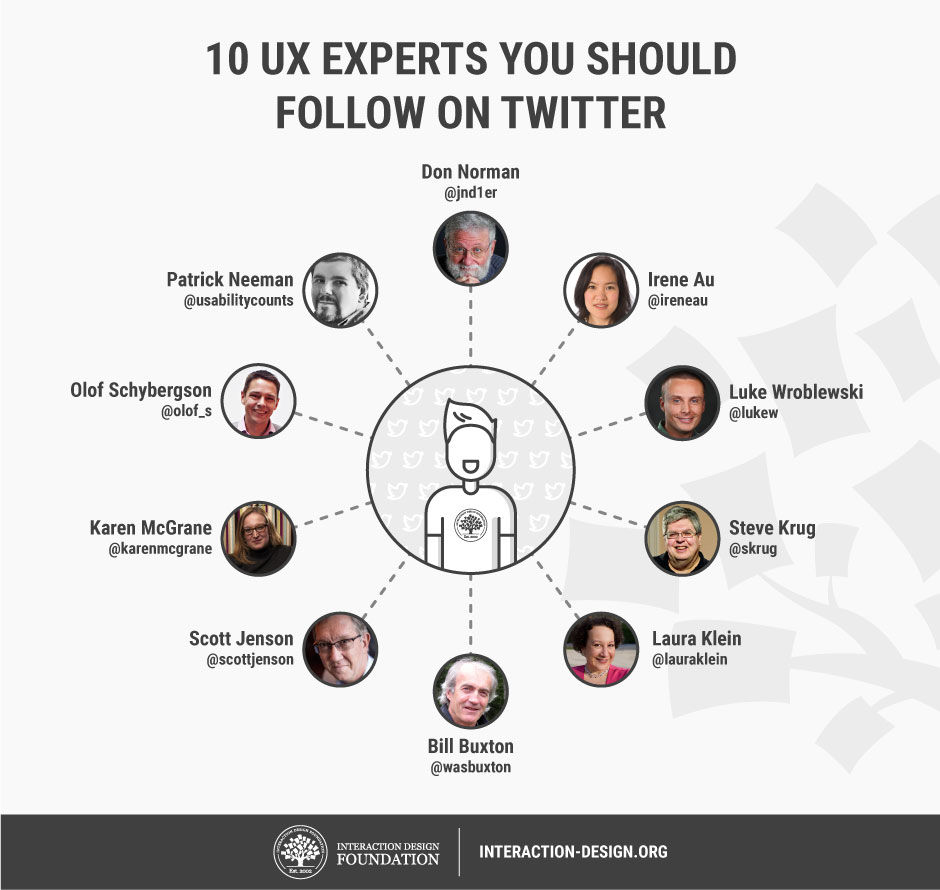
Mentoring and Feedback
Business managers will probably know just how useful a bit of mentoring can be when you’re trying to develop a career and this is true in UX too. You may be able to persuade someone from your personal network to mentor your UX transition and if you can, that’s awesome. However, if you can’t, you don’t need to feel down. The Interaction Design Foundation membership offers a Design League membership, which includes access to an international mentor network.
The Take Away
You can transition from business management to UX design, especially if you have the right resources. Your first job is to get your skills up to date with what UX professionals do; you can do that through online or classroom or even university-style learning. You’ll then be ready to start looking for that first UX job and you can use a personal and/or professional network to boost your chances of finding the right opportunity. Lastly, working with a mentor can help you polish your performance to make the most of interviews when you land them.
References & Where to Learn More
Payscale’s research on UX Design salaries
Earnings by education: US Bureau Of Labor Statistics











